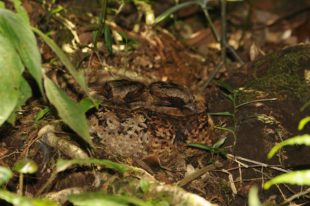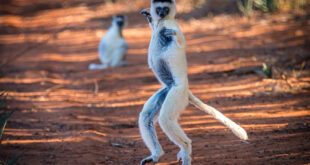Swallows are actually known as diurnal. In the early morning, you can hear their shriiieeh calls, they spend the day in the air. However, the Madagascan Nightjar (Caprimulgus madagascariensis madagascariensis) is an exception. This unusual bird sleeps during the day, pressed close to the ground. The marbled plumage camouflages the animals perfectly, they disappear almost completely from the ground. Even when disturbed, they do not leave their sleeping place far.
But when the sun goes down, the nightjar goes hunting. Its targets are nocturnal insects like cicadas and moths. The insects are preyed on in open terrain and above treetops. The nightjar benefits from its short, very broad beak: It catches the moth in flight like a landing net. Nightjars are enormously skillful, agile flyers, and almost silent when hunting. Their large eyes, set wide to the side of their head, ensure better vision in the dark. Like bats, Madagascar nightjars successfully occupy a small ecological niche. The Madagascan Nightjar weighs just 40 to 50 grams and is 21 to 23 cm long. The middle toe of the feet of the nightjars is extended. It serves as a “cleaning claw” with which the birds can better care for their soft plumage.

The mating season is in the dry season. To impress females, the male nightjar shows so-called butterfly flights. They glide very slowly almost vertically through the air, keeping their wings V-shaped and showing their white wing bandages. Mating takes place on the ground. The male shows his adored one several possible breeding places by flying to the ground and showing a kind of “purring”. The female nightjar finally chooses the place that offers her the best camouflage. The Madagascar Nightjar does not build a real nest. The small, spotted eggs simply land loosely on plants, somewhere in dense undergrowth. With the rainy season the young nightjars hatch. Then the food supply is richest and the chicks have the best starting conditions. As there is no nest, the nightjar protects its young under its wings. This behavior is called “honking”. Both parents take care of feeding the young birds. Several hundred insects bring them to the small, hungry beaks every night. Already at the age of three weeks, Madagascar nightjars can fly and start their own life. Nightjars only gather for one brood. The next season they will tie-up with a different partner.
By the way: Although it is called nightjar, this bird is more related to sailors and hummingbirds. However, there is a closely related other bird species, the European Nightjar (Caprimulgus europaeus). The Madagascar Nightjar currently still has a large population, so its species is not considered endangered. It is found all over the island, in open landscapes up to 1500 m above sea level.
 MADAMAGAZINE Your Magazine about Madagascar
MADAMAGAZINE Your Magazine about Madagascar




